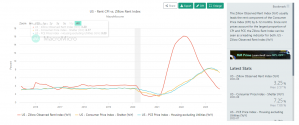Even if we accept these figures, it is inflation rate that has gone down, not inflation itself. Wage growth is 1.2-1.0% on a 3-month seasonally adjusted basis. For the 12-month, non-adjusted, constant dollar, it's 1.6-1.2% for June and worst if we pick earlier months as the basis. Not exactly stellar numbers.
Beyond that, I think their implication (which is one that I have made clear I share in the past), is that those standard excluded items are a huge portion of the usual expenditures of average consumer. If your KPI excludes 56% of the average annual expenditures of a consumer unit ($40,941.93 vs $72,967.36 from 2022 Consumer Expenditure Surveys, BLS) is it even a useful KPI?
No common person's going: well my 44% of my expenses didn't have that much inflation even if the other 56% had a bunch, so inflation is defeated!
I don't know why we shouldn't accept those numbers. I know lots of people like to lean into conspiracy theories about how inflation numbers are all faked, but they have yet to provide a credible alternative. There are a number of inflation measures provided by a number of different institutions who are all saying the same thing. Inflation in general has fallen.
But either way, there is good reason for looking at measures that include all of these items, and measures that exclude them. Paul Krugman isn't saying that volatile items aren't part of a typical consumer basket. He is merely focusing on "core" inflation.
But all of this doomed is propping up this idea that things are horrible now compared to 2016. Things are more difficult sure, but they weren't easy during Trump years either. Things aren't horrible, and they are generally getting better. Like the last time we had a big debate over this, things like egg prices were a temporary blip and have significantly come down since.
Yes, there are significant issues, but I think people should stop being so dismissive. The Fed isn't lowering rates, nobody said the battle is over, but progress has been made.
Below is a comparison of the CPI rent index and actual market rents on Zillow. It's notable that Krugman had to drop the housing component of the CPI even though that component already massively understates actual housing cost inflation.
View attachment 118919
Shelter, food, energy, and transportation commodities (includes used cars as well as others) make up ~62% of the CPI. So Krugman had to exclude the majority of consumer expenditures in order to show inflation is under control.
Yeah? Then why are you cutting out Zillow's graph for the 2023 year?

So who's lying? Zillow or BLS? Or maybe, different data sets tell different things and you need to put in a little more legwork to figure out what they're telling you.
Probably because Shelter is a lagging indicator, and consumers are locked into long-term contracts.
Or did my parents' mortgage suddnely change by 20-30% in the last 5 years? Of course not, they locked it in years ago. Just like rent and lease agreements are locked in on a 6month-2 year basis.
Think people think. Don't just take either headline for granted. It's always either the sky falling, or inflation is going to destroy America. Lol

